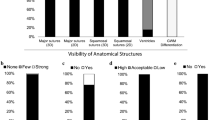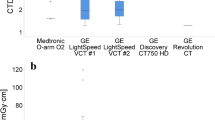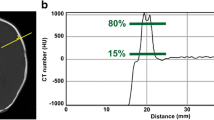Abstract
Background
The role of computed tomography (CT) for diagnosis and surgical planning for craniosynostosis (CS) is well-established. The aim of this study was to quantify the cumulative medical radiation exposure from CT in patients with CS at a tertiary care children’s hospital.
Methods
Medical records of patients who presented at < 2 years of age and underwent surgical intervention for CS were examined for demographic information. Effective radiation dose (ERD) in mSv was calculated for each head CT. Descriptive statistics and ANOVA were performed. Mean ± SD is reported; p < 0.05 was considered significant.
Results
Two hundred seventy-two patients met inclusion criteria: 241 nonsyndromic and 31 with syndromic diagnoses. For nonsyndromic patients, mean age at first head CT was 6.0 ± 4.9 months, mean number of CT scans obtained was 2.1 ± 1.1, and the mean total combined ERD was 9.1 ± 4.8 mSv. CT scans obtained at < 6 months of age had a significantly greater ERD than those obtained at > 6 months, 5.3 ± 1.9 versus 4.3 ± 1.4 mSv, respectively (p = 0.001).
Conclusions
Patients with nonsyndromic CS undergo 2 CT scans on average related to their diagnosis, with a mean total ERD of 9.1 mSv; this is equivalent to 1.5 years of the average annual background radiation dose a person living in the USA will encounter from environmental radiation, medical exposures, and consumer products. A CT obtained at < 6 months is associated with a higher ERD; thus, we recommend delaying imaging from the initial presentation to the time of pre-operative planning when possible.


Similar content being viewed by others
References
Jaskolka MS (2017) Current controversies in metopic suture craniosynostosis. Oral Maxillofac Surg Clin North Am 29:447–463
van der Meulen J (2012) Metopic synostosis. Childs Nerv Syst 28:1359–1367
Beckett JS, Chadha P, Persing JA, Steinbacher DM (2012) Classification of trigonocephaly in metopic synostosis. Plast Reconstr Surg 130:442e-e447
Cohen MM (1986) Craniosynostosis. Diagnosis, evaluatuion, and management 60–2
Gorlin RJ, Cohen Jr MM, Hennekam RC (2001) Syndromes of the head and neck: Oxford university press
Boulet SL, Rasmussen SA, Honein MA (2008) A population-based study of craniosynostosis in metropolitan Atlanta, 1989–2003. Am J Med Genet A 146:984–991
Boyadjiev S (2014) Congenital craniofacial abnormalities. Merck Manual 2105
Sharma RK (2013) Craniosynostosis Indian J Plast Surg 46:18–27
Binaghi S, Gudinchet F, Rilliet B (2000) Three-dimensional spiral CT of craniofacial malformations in children. Pediatr Radiol 30:856–860
Massimi L, Bianchi F, Frassanito P, Calandrelli R, Tamburrini G, Caldarelli M (2019) Imaging in craniosynostosis: when and what? Childs Nerv Syst 35:2055–2069
Deak PD, Smal Y, Kalender WA (2010) Multisection CT protocols: sex-and age-specific conversion factors used to determine effective dose from dose-length product. Radiology 257:158–166
Huda W, Vance A (2007) Patient radiation doses from adult and pediatric CT. Am J Roentgenol 188:540–546
Brenner DJ, Hall EJ (2007) Computed tomography — an increasing source of radiation exposure. N Engl J Med 357:2277–2284
Goske MJ, Applegate KE, Boylan J et al (2008) The Image Gently campaign: working together to change practice. AJR Am J Roentgenol 190:273–274
Donnelly LF, Emery KH, Brody AS et al (2001) Minimizing radiation dose for pediatric body applications of single-detector helical CT: strategies at a large children’s hospital. Am J Roentgenol 176:303–306
Greenwood TJ, Lopez-Costa RI, Rhoades PD et al (2015) CT Dose optimization in pediatric radiology: a multiyear effort to preserve the benefits of imaging while reducing the risks. Radiographics 35:1539–1554
McCollough CH, Bushberg JT, Fletcher JG, Eckel LJ (2015) Answers to common questions about the use and safety of CT scans. Mayo Clin Proc; Elsevier. p. 1380–92
Valentin J (2008) The 2007 recommendations of the international commission on radiological protection. Elsevier
ICRP (2007) Managing patient dose in multi-detector computed tomography (MDCT). ICRP Publication 102; Ann. ICRP 37 (1)
Oikarinen HT, Perttu AM, Mahajan HM et al (2019) Parents’ received and expected information about their child’s radiation exposure during radiographic examinations. Pediatr Radiol 49:155–161
Mathews JD, Forsythe AV, Brady Z et al (2013) Cancer risk in 680,000 people exposed to computed tomography scans in childhood or adolescence: data linkage study of 11 million Australians. BMJ 346:f2360
Brenner DJ, Doll R, Goodhead DT et al (2003) Cancer risks attributable to low doses of ionizing radiation: assessing what we really know. Proc Natl Acad Sci USA 100:13761–13766
Pearce MS, Salotti JA, Little MP et al (2012) Radiation exposure from CT scans in childhood and subsequent risk of leukaemia and brain tumours: a retrospective cohort study. The Lancet 380:499–505
White IK, Shaikh KA, Moore RJ et al (2014) Risk of radiation-induced malignancies from CT scanning in children who underwent shunt treatment before 6 years of age: a retrospective cohort study with a minimum 10-year follow-up. J Neurosurg Pediatr 13:514–519
National Council on Radiation Protection and Measurements (NCRP) (2009) Ionizing radiation exposure of the population of the United States. NCRP 160
Assessment of Variations in Radiation Exposure in the United States (2005) (Accessed 10 Feb 2021, at https://www.nrc.gov/docs/ML1224/ML12240A227.pdf)
Radiation and Your Health: Air Travel. (Accessed 10 Feb 2021, at https://www.cdc.gov/nceh/radiation/air_travel.html)
Oral Health Topics: X-Rays/Radiographs. (Accessed 13 Feb 2021, at https://www.ada.org/en/member-center/oral-health-topics/x-rays)
Pierce DA, Shimizu Y, Preston DL, Vaeth M, Mabuchi K (1996) Studies of the mortality of atomic bomb survivors. Report 12 Part I Cancer: 1950-1990. Radiat Res 146:1–27
Radiation Emergencies: Radiation Thermometer. (Accessed 12 Jan 2021, at https://www.cdc.gov/nceh/radiation/emergencies/radiationthermometer.htm)
Fearon JA, Singh DJ, Beals SP, Yu JC (2007) The diagnosis and treatment of single-sutural synostoses: are computed tomographic scans necessary? Plast Reconstr Surg 120:1327–1331
Slovis TL (2003) Children, Computed tomography radiation dose, and the as low as reasonably achievable (ALARA) Concept. Pediatrics 112:971
Morton RP, Reynolds RM, Ramakrishna R et al (2013) Low-dose head computed tomography in children: a single institutional experience in pediatric radiation risk reduction: clinical article. J Neurosurg Pediatr 12:406–410
Paterson A, Frush DP, Donnelly LF (2001) Helical CT of the body: are settings adjusted for pediatric patients? AJR Am J Roentgenol 176:297–301
Ho OA, Saber N, Stephens D et al (2017) Comparing the Use of 3D photogrammetry and computed tomography in assessing the severity of single-suture nonsyndromic craniosynostosis. Plast Surg (Oakv) 25:78–83
Wilbrand JF, Szczukowski A, Blecher JC et al (2012) Objectification of cranial vault correction for craniosynostosis by three-dimensional photography. J Craniomaxillofac Surg 40:726–730
McKay DR, Davidge KM, Williams SK et al (2010) Measuring cranial vault volume with three-dimensional photography: a method of measurement comparable to the gold standard. J Craniofac Surg 21:1419–1422
Wong JY, Oh AK, Ohta E et al (2008) Validity and reliability of craniofacial anthropometric measurement of 3D digital photogrammetric images. Cleft Palate Craniofac J 45:232–239
Schaaf H, Pons-Kuehnemann J, Malik C et al (2010) Accuracy of three-dimensional photogrammetric images in non-synostotic cranial deformities. Neuropediatrics 41:24–29
Author information
Authors and Affiliations
Contributions
All authors contributed to the study conception and design. Material preparation, data collection, and analysis were performed by Madeleine K. Bruce and Aditya M. Mittal. The first draft of the manuscript was written by Madeleine K. Bruce, and all authors commented on previous versions of the manuscript. All authors read and approved the final manuscript.
Corresponding author
Ethics declarations
Conflict of interest
Not applicable.
Additional information
Publisher's Note
Springer Nature remains neutral with regard to jurisdictional claims in published maps and institutional affiliations.
Rights and permissions
About this article
Cite this article
Bruce, M.K., Mittal, A.M., Whitt, D.S. et al. Computed tomography associated radiation exposure in children with craniosynostosis. Childs Nerv Syst 37, 2635–2641 (2021). https://doi.org/10.1007/s00381-021-05254-0
Received:
Accepted:
Published:
Issue Date:
DOI: https://doi.org/10.1007/s00381-021-05254-0




